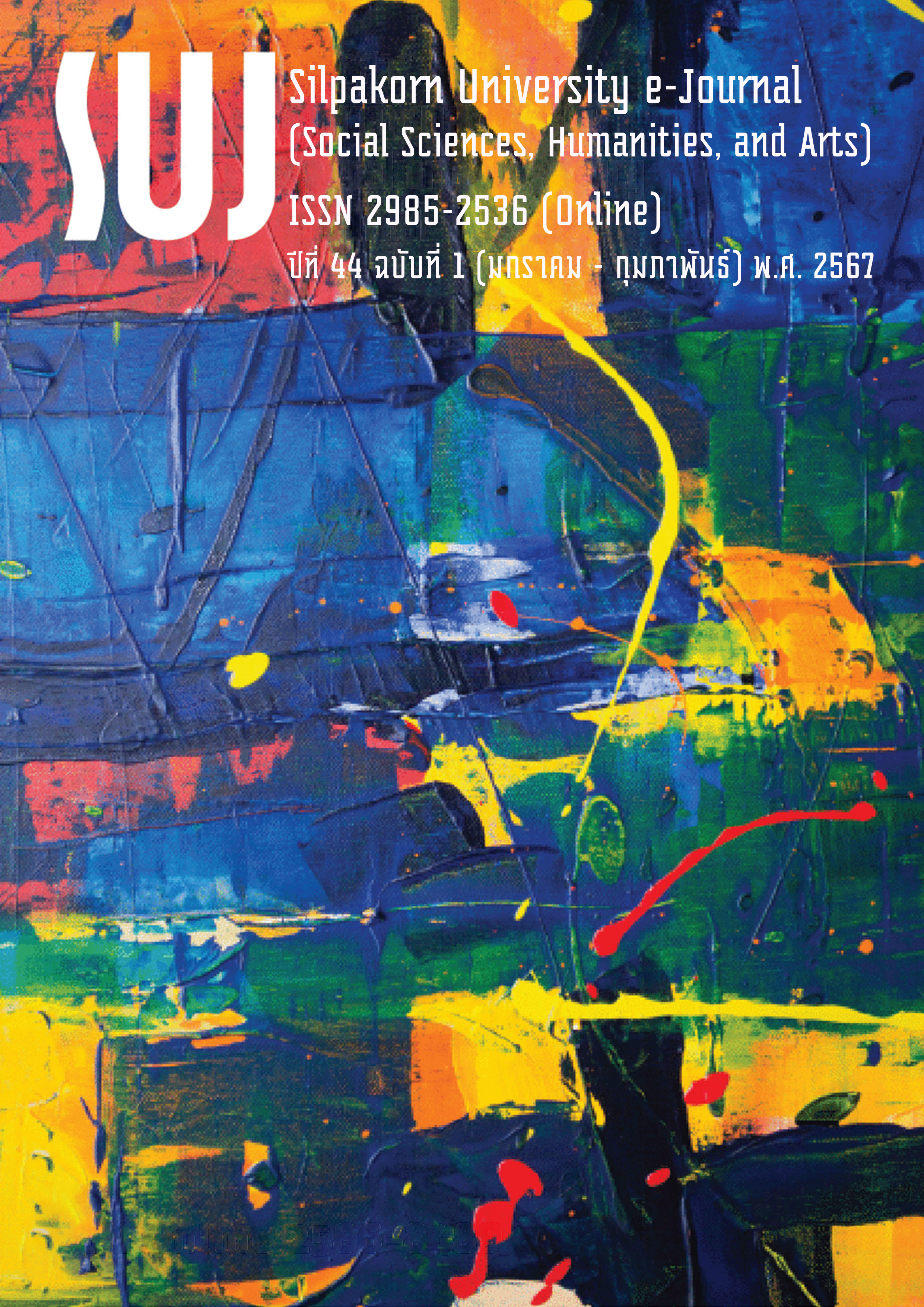การวิเคราะห์รูปแบบสัญญาณไฟจราจรและระบบการจัดแถวคอยการเข้าประตูตรวจสอบของรถบรรทุกตู้คอนเทนเนอร์ ณ ท่าเรือแหลมฉบัง (Analysis of the traffic light cycle and inspection gate queuing system of container trucks at Laem Chabang Port)
Main Article Content
Abstract
ท่าเรือแหลมฉบังเป็นท่าเรือหลักที่สำคัญสำหรับกระบวนการนำเข้าและส่งออกสินค้าของประเทศไทย การเติบโตของท่าเรือและนิคมอุตสาหกรรมแหลมฉบังส่งผลให้เกิดปัญหาด้านการจราจรโดยรอบ โดยเฉพาะปัญหาการจราจรติดขัดบ่อยครั้งในบริเวณทางเข้าประตูตรวจสอบที่ 3 และ 4 เนื่องจากเป็นเส้นทางที่รถบรรทุกตู้คอนเทนเนอร์ขนาดใหญ่จำเป็นจะต้องเคลื่อนที่ผ่านร่วมกับยานพาหนะประเภทอื่นจำนวนมากในบริเวณทางแยก และด้วยปัจจุบันมีการใช้รูปแบบสัญญาณไฟจราจรแบบคงที่ รถบรรทุกตู้คอนเทนเนอร์จำเป็นจะต้องหยุดรอแม้ในกรณีที่ทิศทางอื่น ๆ มีปริมาณยวดยานจำนวนน้อย ส่งผลให้รอบสัญญาณไฟจราจรไม่สัมพันธ์กับปริมาณรถในแต่ละทางแยก โดยเฉพาะในช่วงที่มีปริมาณรถหนาแน่น ทำให้เกิดความล่าช้าและเกิดปัญหาแถวคอยสะสม จากเหตุผลข้างต้นผู้วิจัยจึงมีแนวคิดในการวิเคราะห์เพื่อปรับรูปแบบระยะเวลาสัญญาณไฟจราจรใหม่ โดยการประยุกต์การกำหนดระยะเวลาสัญญาณจราจรร่วมกับระบบการจัดแถวคอยของรถบรรทุกก่อนเข้าประตูตรวจสอบโดยใช้การจำลองสถานการณ์ด้วยโปรแกรมจำลองสภาพจราจรในระดับจุลภาค Simulation of Urban MObility รุ่น 1.14.1 ในบริเวณทางแยกประตูตรวจสอบที่ 3 และ 4 ณ ท่าเรือแหลมฉบัง จังหวัดชลบุรี ผลการวิจัยพบว่าทางแยกประตูตรวจสอบที่ 3 ควรปรับปรุงสัญญาณไฟจราจรด้วยวิธีการใช้พื้นที่ว่างหลังแถวคอยบนถนนของทางแยกปลายทางได้ผลลัพธ์ดีที่สุด คือ 1) ความยาวแถวคอยเฉลี่ยที่ทางแยกลดลงร้อยละ 3.9 และ 2) ความยาวเฉลี่ยแถวคอย ณ ประตูตรวจสอบ ลดลงร้อยละ 11.84 สำหรับทางแยกประตูตรวจสอบที่ 4 ควรปรับปรุงสัญญาณไฟจราจรด้วยวิธีการรอบสัญญาณไฟสั้นร่วมกับระบบจัดการแถวคอยแบบรวมกลุ่มได้ผลลัพธ์ดีที่สุด คือ 1) ความยาวแถวคอยเฉลี่ยที่ทางแยกลดลงร้อยละ 36.77 และ 2) ความยาวเฉลี่ยแถวคอย ณ ประตูตรวจสอบ ลดลงร้อยละ 91.51 ประโยชน์ของการวิจัยครั้งนี้สามารถให้หน่วยงานที่เกี่ยวข้องกับงานด้านการจราจรสามารถนำไปประยุกต์ใช้สำหรับการกำหนดมาตรฐานรอบสัญญาณไฟจราจรที่เหมาะสมในพื้นที่ท่าเรือแหลมฉบังและพื้นที่อื่น ๆ ได้ต่อไป
Laem Chabang Port plays a crucial role as the main import and export hub in Thailand. The growth of the port and surrounding industrial estates has led to traffic issues in the area, particularly frequent traffic jams at Gates 3 and 4 entrances during peak periods. Large trucks must navigate intersections with various vehicles. At present, a fixed traffic light pattern is in use. Container trucks need to stop, even when the volume in the other direction is low. This results in the traffic signal cycles being unrelated to the vehicle volume at each intersection, particularly during peak traffic periods, leading to delays and queue accumulation. After reviewing the results, the researcher developed a solution for analyzing and optimizing traffic light timing. This involves applying synchronized traffic signals alongside a truck queuing system before entering the inspection gate. The analysis is conducted using the Simulation of Urban Mobility software (version 1.14.1) to model traffic scenarios at the microscopic level. Focused on the intersections at Inspection Gates 3 and 4 at Laem Chabang Port, Chonburi Province, the findings recommend improving the traffic signal at Gate 3 through Queue Storage Capacity. This approach yields the following results: 1) a 3.9% reduction in the average queue length at the intersection, and 2) an 11.84% decrease in the average queue length at the inspection gate. As for Gate 4, the traffic light should be improved using a Short Cycle Length and Pooled queuing management system, resulting in the following outcomes: 1) a 36.77% reduction in the average length of queues at intersections, and 2) a 91.51% decrease in the average queue length. The research findings can assist traffic agencies in establishing appropriate traffic light standards for Laem Chabang Port and other locations.
Downloads
Article Details

This work is licensed under a Creative Commons Attribution-NonCommercial-NoDerivatives 4.0 International License.
References
Anurak, Sarintip, Seksan, Jariya, Choosombat, Chanadda, Kumkrut, Titikan, & Wongsuthep, Supitcha. (2021). The application of simulation technique in traffic lights timing for reducing the waiting time at Thakub Intersection, Muang District, Surat Thani Province (การประยุกต์ใช้เทคนิคการจำลองสถานการณ์เพื่อลดระยะเวลารอคอยสัญญาณไฟจราจร ณ แยกท่ากูบ อำเภอเมือง จังหวัดสุราษฎร์ธานี). Thai Industrial Engineering Network Journal, 7(1): 15-22.
Behrisch, M., Bieker, L., Erdmann, J., & Krajzewicz, D. (2011). SUMO – Simulation of Urban MObility: An Overview. [Online]. Retrieved August 1, 2022 from https://www.researchgate.net/publication/225022282_SUMO_-_Simulation_of_Urban_MObility_An_Overview
Buahome, Siwa, Satiennam, Wichuda, & Satiennam, Thaned. (2020). Driver’s speed and stop/go decision during the onset of yellow: A high-speed urban mixed traffic intersection case study (พฤติกรรมการใช้ความเร็วและการตัดสินใจของผู้ขับขี่ที่เข้าทางแยกในช่วงสัญญาณไฟเหลือง: กรณีศึกษาทางแยกความเร็วสูงสภาพการจราจรแบบผสมในเขตเมือง). KKU Research Journal (Graduate Studies), 20(1): 126-137.
Indee, Teedanai, & Pitaksringkarn, Jumrus. (2021). Analyzing a mixed toll collection system using traffic microsimulation models: A case study of Din Daeng Toll Plaza (การวิเคราะห์ระบบเก็บค่าผ่านทางแบบผสมผสานโดยใช้แบบจำลองสภาพจราจรระดับจุลภาค: กรณีศึกษา ด่านเก็บค่าผ่านทางพิเศษดินแดง). Ladkrabang Engineering Journal, 38(1): 1-14.
Kamollimsakul, Wannisa, & Pitaksringkarn, Jumrus. (2018). Traffic operational analysis of continuous flow urban interchange using micro simulation modeling technique : A case study of Dat Daruni School, Chachoengsao (การวิเคราะห์จราจรทางแยกแบบไหลต่อเนื่องผสมผสานกับทางแยกต่างระดับโดยแบบจำลองจราจรระดับจุลภาค : กรณีศึกษาแยกหน้าโรงเรียนดัดดรุณี จ. ฉะเชิงเทรา). Ladkrabang Engineering Journal, 35(1): 23-32.
Kantanon, Vanchai. (2018). Determining the Use of Coordinated Signal Control Case Study: Intersection Network on Mahidol Road, Chiang Mai Province (การพิจารณาเลือกใช้ระบบควบคุมสัญญาณไฟจราจรแบบต่อเนื่อง กรณีศึกษา: โครงข่ายทางแยกบนถนนมหิดล จังหวัดเชียงใหม่). Master’s dissertation, Thammasat University, Pathum Thani, Thailand.
Magala, M., & Sammons, A. (2008). A new approach to port choice modelling. Maritime Economics and Logistics, 10(1-2): 9-34.
Minh, C. C., & Huynh, N. (2014). Planning-level tool for assessing and optimizing gate layout for marine container terminals. Transportation Research Record, 2409(1): 31-39.
Nigam, A., Chaturvedi, M., & Srivastava, S. (2022). An empirical study on parameters affecting traffic stream variables under rainy conditions. In Proceeding of 14th International Conference on COMmunication Systems & NETworkS (COMSNETS 2022), (pp. 818-823). Bangalore, India: IEEE.
Popa, A., & Strer, J. (2016). Analysis of passenger and vehicle flows with microscopic simulations as a result of security checks at Ferry Terminals. Transportation Research Procedia, 14: 1384-1393.
Suanchan, Ladawan, & Pitaksringkarn, Jumrus. (2020). A study of traffic signal coordination system: A case study of the Royal Initiate Project Road of His Majesty King Rama IX (การศึกษาระบบการประสานสัญญาณไฟจราจร : กรณีศึกษาถนนโครงการพระราชดำริของพระบาทสมเด็จพระเจ้าอยู่หัวรัชกาลที่ 9). Engineering Journal of Research and Development, 31(1): 73-85.
Tuntivejakul, Ud. (2015). Application of Congestion Charge to Reduce Congestion within Laem Chabang Port (การประยุกต์ใช้ค่าธรรมเนียมการจราจรคับคั่งเพื่อลดปัญหาการจราจรติดขัดในท่าเรือแหลมฉบัง). Master’s dissertation, Burapha University, Chonburi, Thailand.
Wichaimethawee, Thawee. (2002). Development of Traffic Signal Control Strategies for Saturated Traffic Conditions (การพัฒนาวิธีควบคุมสัญญาณไฟจราจรในสภาพการจราจรอิ่มตัว). Master’s dissertation, Chulalongkorn University, Bangkok, Thailand.
Yaibok, Chaiwat, & Luathep, Paramet. (2015). An analysis of traffic management of multiple consecutive intersections: A case study of Hat Yai Municipality (การวิเคราะห์การจัดการจราจรของชุดทางแยกต่อเนื่องกรณีศึกษาเทศบาลนครหาดใหญ่). UBU Engineering Journal, 8(1): 103-114.


